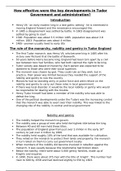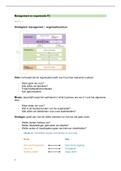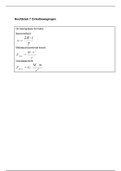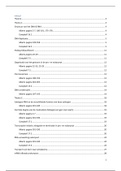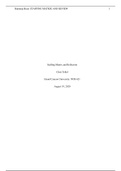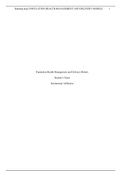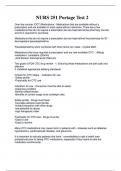How effective were the key developments in Tudor
Government and administration?
Introduction
Henry VII: ‘an early modern king in a late gothic setting’- he is interested in
moving England forward and the renaissance encouraged this.
In 1485 a disagreement was settled by battle. In 1603 disagreement was
settled by going to court
1340- Population was about 5.5 million.1485- population was about 2.8
million. 1603- Population was about 4 million.
1485- yeomen usually lived to early 30s
The role of the monarchy, nobility and gentry in Tudor England
The first Tudor monarch, was Henry VII, who became king in 1485 after his
victory over Richard III at the battle of Bosworth.
50 years before Henry became king, England had been torn apart by a civil
war between two rival families, who had both claimed the right to be king.
Tudor society was based on hierarchy. Each person was expected to be
obedient to those who were their social superiors
The monarch was chosen by god. They could rule as they wish, but in
practice, their power was limited because they needed the support of the
nobility and gentry to rule the country.
Monarchs had no standing army or police force and were reliant on the
nobility and gentry to carry out these roles in local government.
If there was local disorder, it would be the local nobility or gentry who would
be responsible for dealing with the trouble.
Henry Tudor himself had been a member of the nobility who was able to
defeat the king.
One of the political developments under the Tudors was the increasing control
that the monarch was able to exert over their nobility. This was linked to the
changing role of the nobility in central and local government
Nobility and gentry
The nobility helped the monarch to govern.
The nobility was a group of men who held the highest title below the king
Between 40 and 60 men held these titles.
The population of England grew from just over 2 million in the early 16th
century to just over 4 million by 1600.
The nobility held roughly 10% of the land that was available for cultivation.
They relied on the monarch to protect their lands and property; the monarch
in turn relied on them to carry out government locally
When members of the nobility did become involved in rebellion against the
monarch, it was usually because this relationship had broken down.
Below the nobility, there were about 5,000 gentry families, made up of
Knights and esquires.
In 1490, there were about 375 men with the title of ‘knight’. This number had
risen to 600 by 1558 and had declined slightly to 550 by 1603.
, Esquires were of a slightly lower rank than knights and did not have a title.
The gentry were landowner as well, though their estates were generally less
extensive than those of the nobility
Yeomen and artisans
Yeomen were prosperous farmers who tended to own their own land
Estimated that there were many have been about 60,000 of these men by
1600
These farmers were relatively financially secure because they were less
affected by price rises or rent increases.
Artisans were skilled craftsmen who often lived in towns or larger villages
Skilled craftsmen became particularly prosperous in the wool and cloth
industry , which was the main English export throughout the Tudor period
In early Tudor period, it was often the yeomen and artisan who provided the
leadership and shaped the demands of popular rebellion because they were
better educated and were natural leaders of their communities
Peasants
The majority of England’s population still lived and worked in rural
communities and England’s economy remained based on agriculture
Peasantry worked on the land for the local landlord for wages. They did not
own the land. They were reliant for the production of food for their own
survival
They were the most vulnerable to social and economic changes, such as poor
harvests, epidemics and price and rent increase
Its estimated that about two-fifths of the English population were living on
the margins of subsistence
Vagrants/ beggars
Vagrants and beggars were people without masters who roamed the
countryside
They were particularly feared because every person was supposed to be
under the control of their social superiors
This group was seen to be a threat to social order because their movement
around England could lead to the spread of rumours and dangerous ideas
They were treated harshly and punished under Tudor Acts of parliament
The monarchy and government
Tudor monarchy was personal- they would make key decisions about policy
It was essential that the ruler was adult, competent and male- it was assumed
that women were incapable of ruling on their own.
It was the monarch’s duty to protect their country from invasion, lead an army
into battle, protect the rights and privileges of their subjects (ensure law and
order)
Their powers were curbed by Magna Carta (written in 1215)
Monarchs who had tried to ignore these constraints, such Richard II and
Richard III had been labelled tyrants and overthrown
By 1485, a complex system of government has evolved which could both help
and hinder the monarchs in their rule
Government and administration?
Introduction
Henry VII: ‘an early modern king in a late gothic setting’- he is interested in
moving England forward and the renaissance encouraged this.
In 1485 a disagreement was settled by battle. In 1603 disagreement was
settled by going to court
1340- Population was about 5.5 million.1485- population was about 2.8
million. 1603- Population was about 4 million.
1485- yeomen usually lived to early 30s
The role of the monarchy, nobility and gentry in Tudor England
The first Tudor monarch, was Henry VII, who became king in 1485 after his
victory over Richard III at the battle of Bosworth.
50 years before Henry became king, England had been torn apart by a civil
war between two rival families, who had both claimed the right to be king.
Tudor society was based on hierarchy. Each person was expected to be
obedient to those who were their social superiors
The monarch was chosen by god. They could rule as they wish, but in
practice, their power was limited because they needed the support of the
nobility and gentry to rule the country.
Monarchs had no standing army or police force and were reliant on the
nobility and gentry to carry out these roles in local government.
If there was local disorder, it would be the local nobility or gentry who would
be responsible for dealing with the trouble.
Henry Tudor himself had been a member of the nobility who was able to
defeat the king.
One of the political developments under the Tudors was the increasing control
that the monarch was able to exert over their nobility. This was linked to the
changing role of the nobility in central and local government
Nobility and gentry
The nobility helped the monarch to govern.
The nobility was a group of men who held the highest title below the king
Between 40 and 60 men held these titles.
The population of England grew from just over 2 million in the early 16th
century to just over 4 million by 1600.
The nobility held roughly 10% of the land that was available for cultivation.
They relied on the monarch to protect their lands and property; the monarch
in turn relied on them to carry out government locally
When members of the nobility did become involved in rebellion against the
monarch, it was usually because this relationship had broken down.
Below the nobility, there were about 5,000 gentry families, made up of
Knights and esquires.
In 1490, there were about 375 men with the title of ‘knight’. This number had
risen to 600 by 1558 and had declined slightly to 550 by 1603.
, Esquires were of a slightly lower rank than knights and did not have a title.
The gentry were landowner as well, though their estates were generally less
extensive than those of the nobility
Yeomen and artisans
Yeomen were prosperous farmers who tended to own their own land
Estimated that there were many have been about 60,000 of these men by
1600
These farmers were relatively financially secure because they were less
affected by price rises or rent increases.
Artisans were skilled craftsmen who often lived in towns or larger villages
Skilled craftsmen became particularly prosperous in the wool and cloth
industry , which was the main English export throughout the Tudor period
In early Tudor period, it was often the yeomen and artisan who provided the
leadership and shaped the demands of popular rebellion because they were
better educated and were natural leaders of their communities
Peasants
The majority of England’s population still lived and worked in rural
communities and England’s economy remained based on agriculture
Peasantry worked on the land for the local landlord for wages. They did not
own the land. They were reliant for the production of food for their own
survival
They were the most vulnerable to social and economic changes, such as poor
harvests, epidemics and price and rent increase
Its estimated that about two-fifths of the English population were living on
the margins of subsistence
Vagrants/ beggars
Vagrants and beggars were people without masters who roamed the
countryside
They were particularly feared because every person was supposed to be
under the control of their social superiors
This group was seen to be a threat to social order because their movement
around England could lead to the spread of rumours and dangerous ideas
They were treated harshly and punished under Tudor Acts of parliament
The monarchy and government
Tudor monarchy was personal- they would make key decisions about policy
It was essential that the ruler was adult, competent and male- it was assumed
that women were incapable of ruling on their own.
It was the monarch’s duty to protect their country from invasion, lead an army
into battle, protect the rights and privileges of their subjects (ensure law and
order)
Their powers were curbed by Magna Carta (written in 1215)
Monarchs who had tried to ignore these constraints, such Richard II and
Richard III had been labelled tyrants and overthrown
By 1485, a complex system of government has evolved which could both help
and hinder the monarchs in their rule


